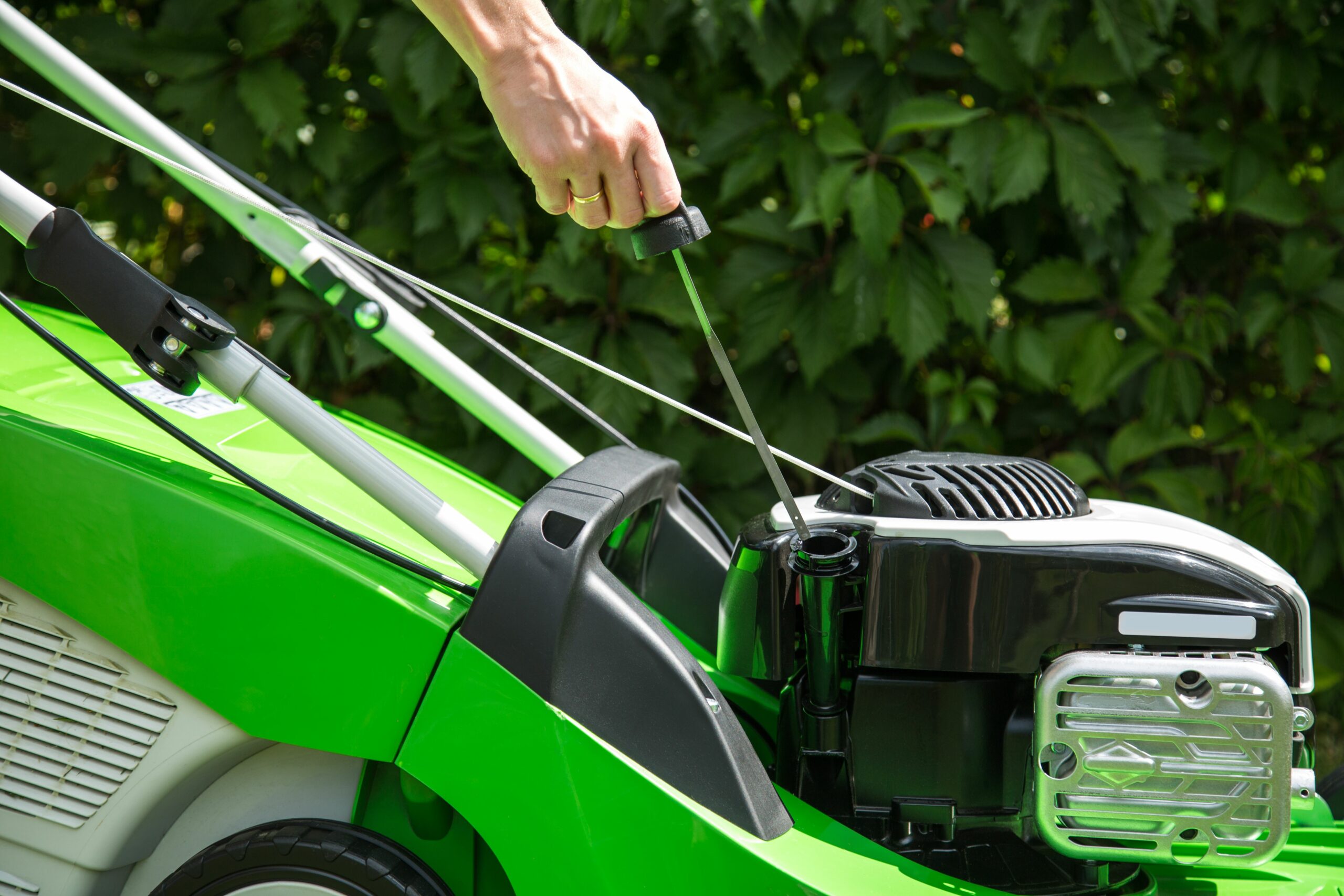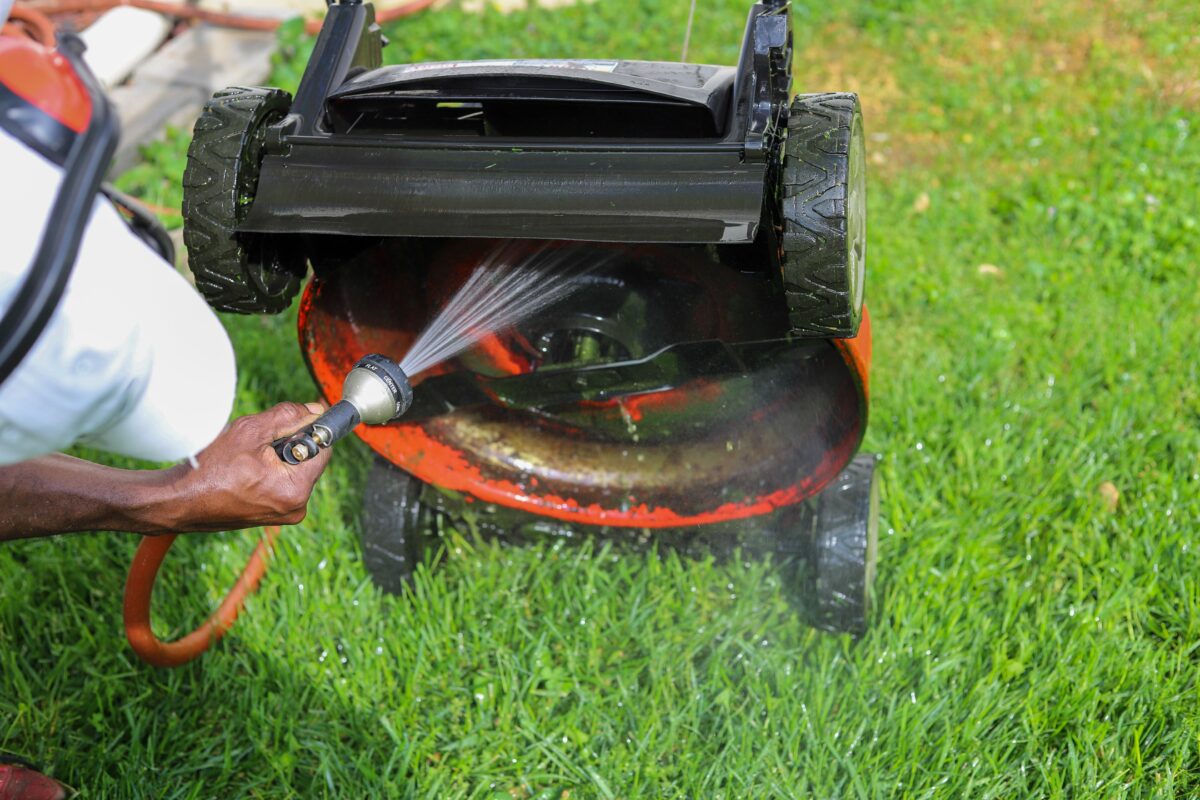Oil is used to lubricate the moving parts of an engine in order to reduce the heat and wear produced by friction. Small engines, like those used in lawn mowers, should have the oil changed about once every 25 to 50 hours of use for optimal efficiency.
However, the old oil from a lawn mower picks up various contaminants, including lead, cadmium, chromium, arsenic, and more. If the oil is tossed with your regular garbage collection, there is a high chance that it will end up in a landfill somewhere. The old oil can then seep into the soil, where it may contaminate the groundwater, putting plants, animals, and humans at risk. Instead, learn how to properly dispose of old lawn mower oil through a local recycling center, a service establishment that provides oil changing services, or a retail establishment that sells significant quantities of new oil.
How to Remove Oil from a Lawn Mower
Changing the oil in a lawn mower is a relatively straightforward process that should be completed at least once every mowing season to keep the lawn mower in good condition. Before getting started, gather the tools and materials necessary for the job including a new oil pan, a sealable container, and new oil to refill the mower. You may also need a new oil filter and an oil filter wrench if you have a riding mower with a replaceable filter.
Step 1: Run Mower: Turn on the mower and let it idle for about 15 minutes to warm up the oil left in the engine. This makes it easier to drain the oil.
Step 2: Turn Off Mower: After 15 minutes turn off the engine, then disconnect the spark plug to avoid accidentally starting the mower during the oil change.
Step 3: Place Oil Pan: Place a sheet of cardboard on the ground, then position the oil pan in the center of the cardboard. The oil pan will catch most of the oil, while the cardboard soaks up any oil spills that may occur.
Step 4: Remove Cap and Oil: Remove the oil cap, then grip the lawn mower with both hands and tip it to the side to pour the old oil out of the mower and into the oil pan. Alternatively, if your lawn mower has a drain plug for the oil, position the oil pan directly under the drain plug, then remove the plug and allow the oil to drain completely.
Step 5: Replace Oil Filter: Use an oil filter wrench to loosen and remove the existing oil filter, if necessary, then slide the new oil filter in place before tightening the fasteners.
Step 6: Add New Oil: Add new oil to the lawn mower, then use the dipstick to ensure the oil is at the correct level before screwing the oil cap back into placing and wiping away any oil that may have spilled.
Clean up the area, then start the lawn mower to check that the oil change was a success. Let the mower run for a few minutes to help circulate the oil through the system, then turn off the mower and conduct a quick inspection to ensure there aren’t any leaks.
How to Properly Dispose of Old Lawn Mower Oil
In many areas, disposing of old lawn mower oil properly is not only the right thing to do for the environment, it’s actually required by law. With that in mind, before changing the oil in your lawn mower, it’s necessary to learn how to properly dispose of old lawn mower oil.
Keep old lawn mower oil in a clean plastic container with a tight-fitting lid, then store it in a cool, dark location, like a shed or garage until you can dispose of it properly. Make sure to keep the used oil separate from other chemical wastes, like gasoline, turpentine, or other solvents.
Contact the local trash company, recycling center, or government office to find out where to take your old oil. Alternatively, you may be able to find a nearby location through Earth911, which is a website that allows you to search by your zip code and the item or items you want to recycle.
In most communities, old oil can be disposed of properly by taking it to a local recycling center. However, you may be able to take it to a service establishment that provides oil-changing services, like gas stations, car garages, dealerships, marinas, or quick lube businesses.
Another option is to dispose of old oil through a retail establishment that sells a significant amount of new lubricating oil, such as an automotive parts store or a big box store. Just keep in mind that there may be a disposal fee, so make sure to contact the location ahead of time to get all the details.
Safety Tips
There are a few safety tips that can make the process easier and keep you safe when you are removing and disposing of old lawn mower oil.
- Wear gloves and safety glasses to protect your hands and eyes while draining the oil from the lawn mower.
- Store the old lawn mower oil in a sealed container to avoid rancidity, attracting pests, or creating a fire hazard.
- Never pour oil down the drain. It can damage the pipes, causes clogs, and it may contaminate the water supply by backing up in sewers and eventually seeping into the groundwater.
- Work with a second person if the lawn mower is too heavy to tip on your own. While some lawn mowers have a drain plug for the oil, this isn’t the case for most models, but if the machine is too heavy for one person to control, have a second person nearby to assist.
- Check local regulations and use a designated oil disposal facility to ensure the old oil will be accepted and disposed of properly. You can usually contact your local recycling center for the location and other pertinent information.
When Should You Replace Lawn Mower Oil?
Generally, the oil in a push mower should be replaced about once every 25 to 50 hours, though some differences exist between specific models, so it’s important to check the information provided in the owner’s manual. Riding mowers can typically go for a longer period without any oil change. Plan to change the oil about once every 75 to 100 hours of use.
Additionally, if the oil seems black, unclean, or gritty when you check it with the dipstick, then it’s recommended to change the oil. Similarly, you should consider changing the oil if the engine seems slower, makes odd or harsh-sounding noises, runs less efficiently, or if you smell a burning odor from the engine. Ultimately, as long as you change the oil at least once a season or as needed, it should help keep the lawn mower operating efficiently for years.



